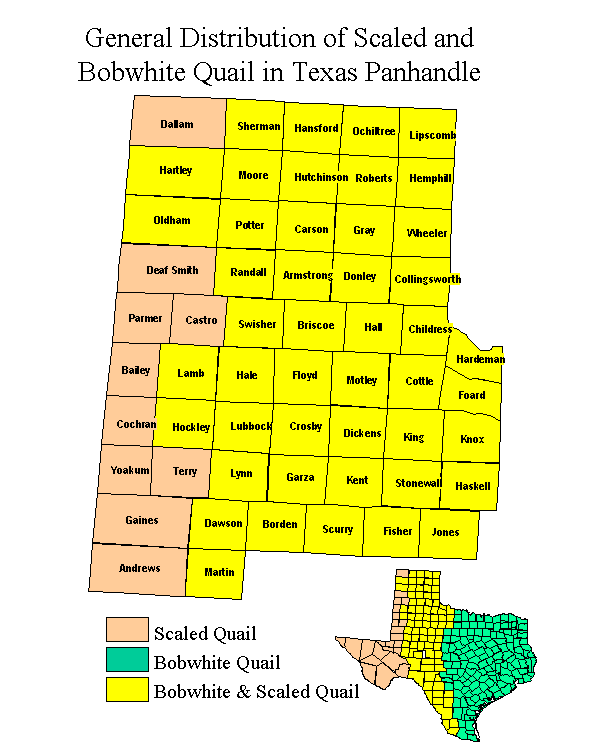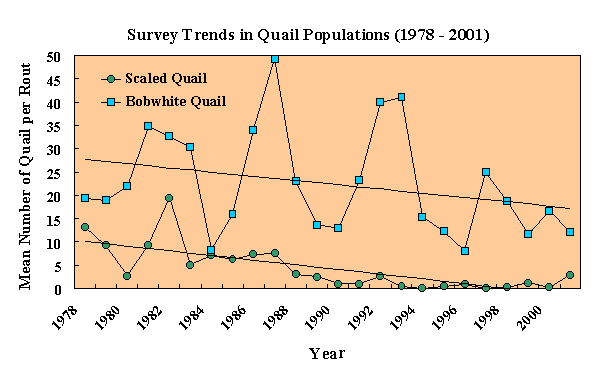Scaled Quail Management in the Texas Panhandle
Distribution

Scaled Quail (Callipepla squamata), often called "blue quail," "cotton top," "blue racer quail," or " Mexican quail" are native to the Chihuahuan desert and the surrounding grasslands of the southwestern portion of the United States and Northern Mexico. There are four subspecies of Scaled quail: C.s. castanogastris in southern Texas and eastern Coahuila Mexico; C.s. pallida in southern Arizona, southern New Mexico, and western Texas; C.s. hargravei in western Oklahoma, South western Kansas, south-eastern Colorado, northern New Mexico, and north west Texas; and C.s.squamata in northern Sonora and Tampaulipas south to the valley of Mexico.
Description
Scaled Quail range in size from 25 to 30 cm (10 - 12 in) in length. Wings, when folded, are 10.9 to 12.1 cm (4.3 - 4.8 in) in males, and 11.0 to 12.0 cm (4.3 - 4.7 in) in females. Tail length ranges from 7.5 to 9.0 cm (3.0 to 3.5 in) in males and 7.5 to 8.8 cm (3.0 - 3.5 in) in females. Average weights for males and females are 179 g and 173 g, respectively. Sexes are similar in appearance. Both are bluish gray with extensive markings on the back, breast, and abdomen with blackish "scaly" markings. Crest varies in color from buff in females to whitish in males. Identification tips are:
- Length: 8 inches
- Small, chunky, short-tailed, round-winged, ground-dwelling bird
- Gray-brown head with white-tipped crest
- Gray-brown upperwings
- Blue-gray about neck, upper back and chest with black scaling
- Buff belly scaled with black, is chestnut on males in south Texas
- Gray flanks with white streaks
Female has less conspicuous crest and dark brown streaks on sides of face and throat
Immature similar to female
Habitat
In the High Plains and Northern Rolling plains they inhabit mostly native gangland, woodland, and brushland ecosystems in varying densities (except the higher-elevation, more mountainous areas). Their range overlaps with bobwhites in most of the Texas Panhandle where both species may be encountered simultaneously. Scale Quail habitat is generally arid to semi-arid, averaging 8-15" of precipitation annually. This species seems to prefer calcareous soils associated with mesquite and juniper grassland, tree cholla and prickly pear, and other native grasses and shrubs. Survival is reduced in areas that lack heavy cover.
Population Trends

In the Panhandle, annual populations fluctuate widely with rainfall, temperature, land use patterns and quality of habitat available, which provides necessary food, cover, water, and proper spacing of these habitats. This species may concentrate in large coveys of 30 or more birds during the winter months and prefers to run rather that hold and flush like bobwhites. Populations of Scaled Quail have declined significantly throughout their range in the Texas Panhandle; however, were good rangeland grazing management is practiced populations of this species remain abundant. Refer to the Texas Parks and Wildlife
Reproduction
Scaled quail are monogamous ground-nesting birds. Clutch sizes average about 13 to 14 eggs. Eggs weigh an average of 11.2g and have dimensions on average 3.3 x 2.5 cm (1.28 x 0.98 in). Nesting period may extend from May through September. Incubation lasts for about 23 days and young weigh almost as much as a full grown adult at 11 to 15 weeks. Males rarely assist in incubation. Successful nests hatch from 10-14 chicks. Nests are usually found near water and males assist in defending the brood and nest. Nests are usually hidden in thick vegetation. Ovary mass, laying activity, and egg production decrease in drought. Young birds join with other family units to form winter flocks of 20 to 200 birds. During winter the number of birds in a flock decreases from hunting, perdition, weather-related deaths, and other causes. A first-year mortality of 70 percent or more is normal. Scaled quail usually stay in coveys of 17 to 23 until March or April, during which time males initiate fighting and pairs begin to form separately to repeat the reproductive process. Large fluctuations in population size are common from year to year and typically follow several years of drought.
Food
Scaled Quail are generally seed eaters, which are a large part of an adult birds' diet, however, use of seeds fluctuate in importance relative to seed density and availability. In winter birds may feed in the morning in grain stubble, in weed patches on seeds, green leaves, shoots, berries, or on insects. Although many different seeds are eaten, Scaled Quail prefer those from native woody plants and forbs. In agricultural areas, seeds from grasses and field crops may comprise a considerable portion of the diet at times. Preferred seeds include:
- Croton
- Four-winged saltbush - summer food
- Salsola - summer food
- Amaranthus - winter food
- Bristlegrass
- Aromatic sumac - summer food
- Mesquite
- Sunflower - winter food
- Ragweed
- Snakeweed - in areas of abundance and few alternative foods.
- Green herbage - important in winter and spring
- Insects
Young nutritious plant shoots are important to quail preparing for to breed. Plant shoots are also an important source of moisture for quail. Insects are important (spring and summer) as they are the primary food for hatching quail for the first 3-4 weeks of their life. Insects supply the high nutrition necessary for the growth and development of young quail but they also are an important nutrition and water source for adult quail. After the first month, plant material becomes increasingly important in the young quails' diets.
Cover
Cover is an essential part of the Scaled Quail's habitat. Lack of cover and proper dispersion of food and water are limiting factors over much of the species range in Texas. Quality habitat for usually consists of scattered pockets of cover (< 1 acre in 10). Additionally, food resources (i.e., mesquite beans, sumac berries, seeds of small forbs) closely associated with the cover increases its value to local quail populations. Scaled Quail need overhead cover with open space below. This is due to there tendency to run rather than hide or fly when disturbed. Flushed birds often fly a short distance, glide to the ground, and continue to run before seeking the most available cover. A running habit makes this specie of quail difficult to locate and to hunt. Several cover-types may be used by quail, from small forbs and grasses to large woody plants and brush piles. Scaled Quail use cover in several ways:
- Resting or Loafing Cover - Daytime resting or loafing cover provides overhead and lateral protection, has a central vegetation-free area, and offers many avenues of escape. Mesquite, skunkbush, sumac, shinnery oak, cholla, and sandsage provided good loafing cover. Brush piles, abandoned buildings, corrals, and old farm equipment may substitute for natural cover.
- Hiding and Escape Cover - Birds seek hiding and escape cover when flushed. If flushed from hiding cover, birds tend to fly farther and run farther before ducking into other vegetative cover. Hiding cover varies greatly, from grassy and herbaceous plants to woody species and man-made structures. Heavy hunting pressure tends to force Scaled Quail to seek denser cover for hiding.
- Roosting - Scaled Quail roost in small groups, tail-to-tail in a tight circle on the ground. Preference is given to bare ground with leaflitter and grass < 40 cm (16 in) in height for lateral cover. Birds roost among small shrubs, forbs, grasses, and other suitable cover. Roosting habitat free of overhead cover allows birds to fly when threatened by predators.
- Nesting - Nesting cover likely is the most important habitat component for Scaled Quail, because birds are most vulnerable to predation during this time. Good nesting cover must provide concealment for the nest, but cover that is too will impede escape from predators. Nesting success decreases in the absence of good nesting cover.
Water
Water is a critical element of quality Scaled Quail habitat. Although quail generally obtain enough water from their environment (i.e., dew, succulent vegetation, insects), Scaled quail frequently concentrate around a source of free water, which may be a critical factor for survival of immature birds during drought. Birds usually do not travel over 1 km (0.6 mi) for water.
Management Recommendations
General management recommendations for improving quality of Scaled Quail habitat include:
- Natural Habitat Diversity - Maintain natural habitat diversity and consider
quail and other wildlife when land management practices are assessed. Quail
need a wide variety of native plant species, i.e.:
- Grama grass - forage area for broods seeking insects and light cover
- Broom snakeweed - emergency winter feed
- Mesquite - cover and food
- Grazing - Heavy grazing is detrimental to scaled quail habitat and may be harmful during nesting.
- Fencing - Fencing can be used to protect small areas (< 1 acre) from grazing that provide resting and nesting cover, and brood rearing areas.
- Special Management Practices (SMP)- SMP's such as soil tillage or planting
food plots, shrubby species, skunkbush, wildplum, tree cholla, and prickly
pear cactus provide good natural food and cover.
- Brush Piles - Brush piles and stacks of old railroad ties that become overgrown by native vegetation are great for providing cover where natural cover is lacking.
- Water Sources - Supplemental water or access to water year-round can increase survival of young. Water should be provided at ground level, but ramps into and out of stock tanks can provide access and prevent drowning. Where water is limited or absent, development of water sources is desirable, including guzzlers, catchment ponds, windmills, and spring development. Windmills enhance quail habitat if the stock tank has an overflow and waste water is piped away from the drinking tub. Fencing one-half acre where waste water stands is effective in creating habitat for quail. Placing an artificial brush pile in one corner provides temporary cover until natural vegetation can reestablish. Shrubs should be planted close enough to water so that quail may obtain extra water when stressed. Strips can be disked inside the enclosure to allow a place for forbs to grow. It usually takes a couple of years to establish a thriving quail population
Literature
The Birders Handbook: A field guide to the natural history of North American birds. New York: Simon and Schuster Inc.
Robbins, C.S., B. Bruun, and H.S. Zim. 1966. Birds of North America. New York: Western Publishing Company, Inc.
Lehmann, V.W. 1984. Bobwhites in the Rio Grande plain of Texas. Texas A&M University Press, College Station.
Oberholser, H.O. 1974. The bird life of Texas. University of Texas Press, Austin. Texas Game, Fish, and Oyster Commission. 1945. Principal game birds and mammals of Texas. Texas Game, Fish, and Oyster Commission, Austin.
Jackson, A.S., C. Holt, and D.W. Lay. Bobwhite quail in Texas: habitat needs and management suggestions. Texas Parks & Wildlife, Austin. 21pp.
Locate a Wildlife Biologist
For further information here to locate a Wildlife Biologist in your county.